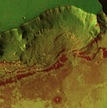Rockslides and Outcrops in Ganges Chasma
This portion of Ganges Chasma, part of the Valles Marineris canyon system, contains several enormous overlapping landslides and provides scientists a view into the misty depths of martian geologic time. Ganges Chasma slices through almost 5 km (3 miles) of the martian crust and reveals ancient rocks and layers in the walls of the canyons that would otherwise be unseen.
This image was created from a mosaic of daytime infrared images colorized with nighttime temperatures. The nighttime temperature identifies the thermo-physical properties of the region, showing warm, rocky areas as red and yellow, while cooler, dusty areas appear as green and blue.

Falling Rock
Lobes from several enormous landslides are visible along the floor of the canyon. Material in a landslide off the north wall of the canyon flowed more than 17km (10 miles) across the canyon floor, eventually coming to rest atop an older landslide from the south wall, that had traveled nearly as far.

Dry History
Outcrops of olivine rich basaltic bedrock can also be seen in this region. In this image these outcrops appear as long, dark red ribbons, running along the base of the canyon walls.
Olivine is a magnesium and iron rich silicate mineral commonly found in lava flows on the Earth. The birthstone for the month of August is a a special type of olivine called peridot. The presence of this mineral indicates that this region has remained relatively dry, because olivine weathers away rapidly in watery environments.